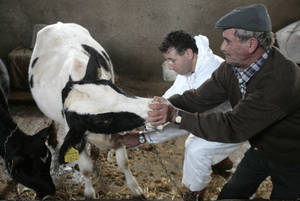[ad_1]

Cattle vaccination in Turkey. Lumpy skin disease used to be confined to Africa only. In 2013, it emerged in Turkey and then spread through Eastern Europe.
26 September 2017, Rome – FAO has called for broader cattle vaccination to keep lumpy skin disease at bay in Eastern Europe and the Balkans, especially in areas where the risk is the highest.
In a position paper published today, FAO warned that even countries that have not been affected by lumpy skin disease so far but are considered at risk need to carry out risk-based vaccination to avert the spread of the disease, which can have devastating consequences for farmers, particularly smallholders.
Lumpy skin disease is a cattle pox virus transmitted by biting insects that can be deadly for cattle but does not affect humans. The disease used to be confined to Africa only. In 2013, it emerged in Turkey and then quickly spread through nine countries in Eastern Europe and the Balkans.
At the height of the disease’s spread in Europe, countries hit by lumpy skin disease registered up to 200 outbreaks, which have led to significant economic losses – due to drops in milk production and reduced quality of skins – and the death of up to around 15 percent of the affected herds.
“Although the outbreak in Europe was contained in April following mass vaccinations, we have seen the disease resurface in recent months in Albania, Greece and Macedonia. It’s just another warning sign that the disease has not been fully contained yet and can keep spreading if we don’t step up efforts to control it,” said Ren Wang, FAO Assistant Director-General, Agriculture and Consumer Protection Department.
FAO urges governments across the regions at risk of lumpy skin disease to carry out vaccination campaigns, especially ahead of bug season, which usually starts in March, when infection rates are highest to prevent, control and eliminate the disease.
Preventive vaccination in Croatia, Bosnia and Herzegovina, and northern Serbia, for example, would create a buffer zone and stop the disease from potentially spreading to neighbouring countries such as Hungary and Romania, which have been spared to date from the disease.
FAO warned that stamping out – the proactive culling of all animals on an infected farm – should be used as a last resort because stamping out can have a drastic impact on farmers’ livelihoods, particularly those of smallholders. If stamping out is considered necessary, FAO recommends for this to be used only in the case of clinically affected cattle, when the infection is confirmed by an authorized laboratory, and animals should be humanely culled and appropriately disposed of as soon as possible.
FAO has already played an important role in reshaping countries’ policies so that vaccination is used as a key measure to prevent lumpy skin disease, and to minimize stamping out.
“Despite the progress made in combatting lumpy skin disease, there are still some grey areas we need to focus on. For one, we need to understand better if lumpy skin disease can also be transmitted from one animal to another via infected milk, for example, and if infected animals that do not show clinical signs could still spread the virus,” said Ren Wang, Assistant Director-General, FAO Agriculture and Consumer Protection Department.
“There is also a need for better regional coordination and heightened surveillance to deal more effectively with the spread of the disease,” added Ren Wang.
[ad_2]
Source link





